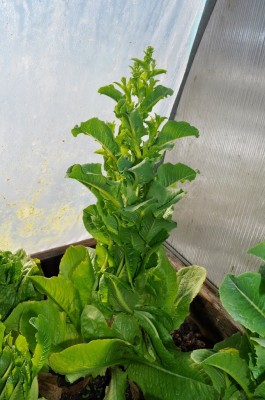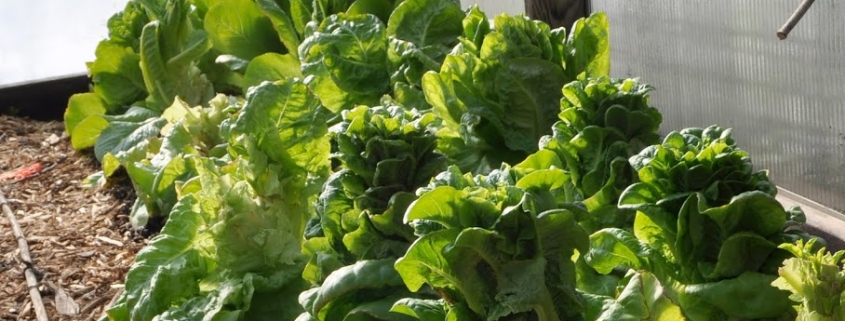[pomegranates, greenhouse lettuce, bad black walnuts]
I oversee, in all probability, the biggest pomegranate farm in Ulster County, perhaps New York State, even the Northeast. My planting recently expanded by 200 percent with the 4 new plants that arrived at my doorstep a couple of days ago. My farm is biggest because so few people in this part of the world grow pomegranates and, if they do, they might have one plant.
Pomegranates are an up and coming plant. Their health benefits have been highly touted, perhaps with some hyperbole. They are beautiful shrubs or small trees with traffic-stopping red (sometimes white or pink) blossoms. Best of all is the fruit’s flavor, combining the richness of berries with the tang of citrus.
Unfortunately, pomegranates are not adapted to growing in this part of the world. They hail from the Mideast, much the same region as figs, where winters are mild and moist, and summers are hot, dry, and sunny. Yet, I, along with many other gardeners, do grow figs, coddling them through winter by growing them in pots brought indoors, in a greenhouse, or swaddled in the ground or, where winters aren’t bitterly cold, in various insulating blankets. Why not do the same with pomegranates? Stems of both plants tolerate temperatures down to about 15° F.
Well, not exactly the same. Figs bear fruit on new wood so you can harvest a crop even if the stems die back, as long as they don’t die back too much. Pomegranates bear fruit on older wood, which needs to survive winter to bear fruit. Pomegranates also need a long season to ripen. And they don’t like humidity, and especially rain near harvest, or the fruits burst open.
All of which is why 12 to 18 inch diameter pots are what my pomegranates call home. I move these pots to my cool basement for winter. I move them outside as soon as the weather warms in spring to get them started early, and inside temporarily if frost threatens. I can move them under cover when rains threaten.
Commercial pomegranates in the U.S. are of varieties from warmer parts of the Mideast. The varieties I am growing are from colder regions — central Asia and Russia — so should better tolerate colder winters. With global warming, I may eventually try overwintering some of these plants outdoors. These varieties also ripen their fruits in shorter seasons. My plants — with exotic names like Kazake, Salavatski, and Sverkhranniy — have yet to flower and fruit. I’m looking forward to harvesting a selection of pink, red, sweet-tart, and sweet pomegranates in the next couple of years.
—————————————————-

A few more years of greenhouse gardening and I may get the hang of it. Up to a few weeks ago, I was so proud of all those beautiful lettuce seedlings I had transplanted into the greenhouse in September, as they swelled up into beautiful buttery and crunchy heads. Now, though, a number of them have telescoped out their once-compact heads in preparation for flowering and going to seed.
Lettuce typically switches to this flowering mode when days are 12 hours, or more, long. Around here, daylight hours through most of September are a bit more than 12 hours long. Still, I couldn’t wait too long to plant because, planted after September, lettuce grows ver-r-r-r-r-y slowly.
And daylength isn’t the only player here; temperature also plays a role, with hotter temperatures coaxing forth those flower stalks, especially when coupled with long days. On sunny days in early autumn, temperatures in the greenhouse did soar to 90°.
There is consolation. When lettuce starts to flower outside during hot, long days of summer, the leaves take on a slightly bluish cast and turn tougher and bitter. Leaves of my bolting greenhouse lettuces are still deep green, succulent, and flavorful.

—————————————————-
Another disappointment, one without a saving grace, are the black walnuts. Back in September, we harvested as usual. Deb took off the husks, I laid the de-husked nuts out to dry, and then packed them away in baskets for a few months of curing. So far, just about all the nutmeats I’ve cracked out are thoroughly dried out or rotten, black, and inedible.
Why? Perhaps it was the summer’s drought. Perhaps the newly husked nuts stayed too wet before being packed away. Perhaps something’s amiss with our old tree. I’ll check some walnuts a friend harvested from a different tree to see if the problem is widespread. Perhaps the late frost affected early nut development. Next September, I’ll check a few nuts when we harvest them.
As consolation, I turn to the words of Charles Dudley Warner (My Summer in a Garden, 1871), “The principle value of the garden . . . is to teach . . . patience and philosophy, and the higher virtue – hope deferred, and expectations blighted, leading directly to resignation, and sometimes to alienation. The garden thus becomes a moral agent, a test of character, as it was in the beginning.”





Lee,
I’m curious as to why you cure them. What does curing do?
A friend of us gave us our first taste of black walnuts this fall and said that he had many, many on the ground that we were welcome to. So we picked up about 100 or so whose coverings were mostly black and rotting off the nut. After cleaning and drying and cracking in a workbench vise, we finished extracting the meat which we put in a jar in the refrigerator. I don’t have a reference point but they tasted wonderful and they seem to be keeping fine.
Mike
Perhaps “curing” isn’t the correct term. Perhaps they just dry out a bit. Perhaps by the time you got to yours, they had already gone through whatever process they go through. In my experience, black walnuts picked up fresh from the ground, husked, and cracked immediately don’t taste good. Also, I think this summer’s drought might have been the cause for this year’s poor nuts because a friend’s harvest from other trees showed the same poor results.
Where did you purchase your pomegranate plants? I live in Albany and would love to give growing my own pomegranates a try.
Ann
I didn’t purchase the plants. I am a member of North American Fruit Explorers (NAFEX.org) and got plants and cuttings from other members. The plants are easy to root from cuttings, and you also might get cuttings to root from the USDA Germplasm Repository in Davis California, where a collection of pomegranate varieties is housed.